Advancing Sustainability and Resilience in Vulnerable Rural and Coastal Communities Facing Environmental Change with a Regionally Focused Composite Mapping Framework
Abstract
1. Introduction
1.1. Literature Review
1.2. Study Objectives and Paper Structure
- A transparent, openly versioned pipeline that links regional data collation, 2D hydraulic simulation (LISFLOOD-FP) and stakeholder-driven composite vulnerability mapping, ensuring full reproducibility at each stage.
- A spatially explicit integration of high-resolution flood-risk outputs with multidimensional socio-economic and health deprivation indices, enabling precise identification of priority zones under present and future climate scenarios.
- A transferable blueprint for equitable adaptation planning that embeds stakeholder engagement and policy relevance, offering practitioners a clear framework for resilient development across similar rural and coastal settings.
- Develop a strategy to optimise coastal prosperity in the face of climate change over the next century.
- Inform resilient spatial development patterns over the next 25 years within a long-term strategic view, enabling communities to thrive.
- Identify routes for community engagement, highlighting the need for resilience and adaptation across socio-economic and environmental considerations.
- Evaluate a multidisciplinary response to various facets of social, economic, and environmental issues, beyond the risk of flooding, considering the prosperity and value of coastal communities.
- Recognise the potential for challenging and controversial decisions, potentially unsupported by legislative or financial frameworks.
2. The Adaptive and Resilient Rural-Coastal Communities in Lincolnshire (ARRCC-L) Framework
Conceptual Design
3. Methodology
- Integrated Flood Risk Management: Develop a holistic catchment-to-coast approach by expanding regional flood risk assessments and adaptation strategies. This ensures inland, coastal, and combined event risks are addressed, avoiding the relocation of communities and infrastructure to equally or more flood-prone areas.
- Strategic Partnership: Foster collaboration between local governments, environmental agencies, and academic institutions. These partnerships strengthen community resilience by combining diverse expertise and resources to inform effective climate adaptation and mitigation efforts.
- Data Integration and Analysis: Systematically model and analyse decades of hydromorphic, hydrological, and historical flood data. This integration is critical for understanding and managing future flood risks while guiding adaptive strategies.
- Coastal Processes: Integrate historical maps, aerial photographs, and satellite imagery to track ongoing coastal processes.
- River Flooding: Use EA flood maps or similar zoning data as a foundation, supplemented by ‘what if’ modelling of future flood extents.
- Infrastructure Vulnerabilities: Analyse historical maps of coastal and river drainage changes, including embankment breaches, to identify weak points in flood protection infrastructure.
- Ecosystem Mapping: Develop maps highlighting ecosystem quality and services—from brownfield sites to woodlands and wildlife sanctuaries—as identified in the ‘Habitat extent and condition, natural capital, UK:2022’ report [72].
- Built Environment Evaluation: Assess property quality and future built environment conditions, incorporating hazard liability and development needs. Explore broader benefits like agricultural, economic, and social value tied to adaptive strategies [9].
- Health, Social, and Economic Data: Create map layers targeting areas needing intervention, ensuring emergency access to properties and health infrastructure—often overlooked in standard planning [62]. These inputs inform the spatial risk platform, quantifying climate risks, impacts, and opportunities [8,73].
3.1. Framework Design
- Data Collation: Integration of regional deprivation indices, infrastructure accessibility, and historical flood records.
- Hydraulic Simulation: Use of LISFLOOD-FP over high-resolution LiDAR terrain data to model fluvial, pluvial, and coastal flood scenarios.
- Composite Vulnerability Mapping: Stakeholder-weighted overlays of hazard exposure and socio-economic indicators to identify priority zones for adaptation.
3.2. Climate Change Scenario Incorporation
4. Results and Evaluation
- Coastal Processes: Locations and estimates of ongoing coastal dynamics derived from satellite imagery.
- Settlement Flood Risk: Environment Agency data combined with ‘what if’ modelling to project future flood extents under climate variability.
- Maps of the built environment, to help with the identification of future hazard liability in key areas of Lincolnshire.
- Built Environment Mapping: Identification of future hazard liabilities in key areas through detailed maps of the built environment. Socio-Economic Benefits: Outputs based on median event likelihoods extrapolated from historical records to depict areas affected, or unaffected, by current and future climate variability, enabling insights into potential growth opportunities.
- Socio-Economic and Health Integration: Flood maps intersected with socio-economic and health data to highlight areas for continued growth or relocation based on informed, impact-minimising strategies.
- Scalable Data Integration: Incorporation of health, social, and economic data at multiple operational scales, enabling targeted interventions in high-priority areas through strategic partnerships and socio-environmental analysis.
4.1. Validation and Long-Term Considerations
4.2. Defence Strategy and Public Perception
5. Conclusions
5.1. Limitations
5.2. Future Research
- dynamic breach and defence-fragility modelling, incorporating a targeted sea-level breach-fragility sensitivity test exploring ± 10 cm perturbations.
- integration of real-time sensor data for event-driven calibration of model parameters.
- detailed cost–benefit analyses of alternative adaptation pathways.
- deployment of stakeholder surveys to assess the socio-political feasibility and uptake of the proposed measures.
5.3. Recommendations for Planners
- Prioritise composite vulnerability mapping to direct flood defence upgrades towards the most socially and economically vulnerable areas.
- Adopt open-source, versioned workflows to promote transparency and enable cross-region comparability of adaptation assessments.
- Embed ARRCC-L outputs within Local Plans and the UK’s climate risk frameworks to align strategic investment with evidence-based adaptation needs.
Author Contributions
Funding
Institutional Review Board Statement
Informed Consent Statement
Data Availability Statement
Acknowledgments
Conflicts of Interest
Abbreviations
| Acronym | Full term | Description |
| ARRCC-L | Adaptation and Resilience for Rural-Coastal Communities in Lincolnshire | Framework integrating high-resolution flood-risk modelling with socio-economic and health data to guide stakeholder-driven adaptation |
| HtL | Hold the Line | Coastal defence strategy focused on maintaining the existing shoreline position with fixed sea- and river-defences |
| MR | Managed Realignment | Defence approach that allows controlled retreat so the shoreline can evolve naturally with changing coastal processes |
| RCP | Representative Concentration Pathway | Greenhouse gas concentration trajectories used in climate modelling |
| SSP | Shared Socioeconomic Pathway | Scenarios of projected societal changes, including demographics and economics, used alongside RCPs |
| FCERM | Flood and Coastal Erosion Risk Management | UK-wide framework for assessing and managing flood and coastal erosion risks |
References
- Parry, L.; Davies, G.; Almeida, O.; Frausin, G.; de Moraés, A.; Rivero, S.; Filizola, N.; Torres, P. Social vulnerability to climatic shocks is shaped by urban accessibility. Ann. Am. Assoc. Geogr. 2018, 108, 125–143. [Google Scholar] [CrossRef]
- Li, A.; Toll, M.; Bentley, R. Mapping social vulnerability indicators to understand the health impacts of climate change: A scoping review. Lancet Planet. Health 2023, 7, e925–e937. [Google Scholar] [CrossRef]
- Ngcamu, B.S. Climate change effects on vulnerable populations in the Global South: A systematic review. Nat. Hazards 2023, 118, 977–991. [Google Scholar] [CrossRef]
- Green, J.; Haigh, I.D.; Quinn, N.; Neal, J.; Wahl, T.; Wood, M.; Eilander, D.; de Ruiter, M.; Ward, P.; Camus, P. Review article: A comprehensive review of compound flooding literature with a focus on coastal and estuarine regions. Nat. Hazards Earth Syst. Sci. 2025, 25, 747–816. [Google Scholar] [CrossRef]
- Holling, C.S. Resilience and stability of ecological systems. Annu. Rev. Ecol. Syst. 1973, 4, 1–23. [Google Scholar] [CrossRef]
- Folke, C. Resilience (republished). Ecol. Soc. 2016, 21, 44. [Google Scholar] [CrossRef]
- Meerow, S.; Newell, J.P.; Stults, M. Defining urban resilience: A review. Landsc. Urban Plan. 2016, 147, 38–49. [Google Scholar] [CrossRef]
- Oppenheimer, M.; Glavovic, B.; Hinkel, J.; van de Wal, R.; Magnan, A.K.; Abd-Elgawad, A.; Cai, R.; Cifuentes-Jara, M.; Deconto, R.M.; Ghosh, T.; et al. Sea level rise and implications for low lying islands, coasts and communities. In IPCC Special Report on the Ocean and Cryosphere in a Changing Climate; Cambridge University Press: Cambridge, UK, 2019. [Google Scholar]
- Zanotti, L.; Ma, Z.; Johnson, J.L.; Johnson, D.R.; Yu, D.J.; Burnham, M.; Carothers, C. Sustainability, resilience, adaptation, and transformation: Tensions and plural approaches. Ecol. Soc. 2020, 25, 4. [Google Scholar] [CrossRef]
- Evans, L.; Blythe, J.; Bennett, N.; Brown, K.; Turner, R.A.; Baggio, J.A.; Baker, D.; Ban, N.C.; Brun, V.; Claudet, J. Triple exposure: Reducing negative impacts of climate change, blue growth and conservation on coastal communities. One Earth 2023, 6, 118–130. [Google Scholar] [CrossRef]
- Galasso, C.; McCloskey, J.; Pelling, M.; Hope, M.; Bean, C.; Cremen, G.; Guragain, R.; Hancilar, U.; Menoscal, J.; Mwelu, K.; et al. Risk-based, Pro-poor Urban Design and Planning for Tomorrow’s Cities. Int. J. Disaster Risk Reduct. 2021, 58, 102158. [Google Scholar] [CrossRef]
- Bates, P.D.; Savage, J.; Wing, O.; Quinn, N.; Sampson, C.; Neal, J.; Smith, A. A climate-conditioned catastrophe risk model for UK flooding. EGUsphere 2022, 1–29. [Google Scholar] [CrossRef]
- Joseph Rowntree Foundation. UK Poverty Statistics. 2022. Available online: https://www.jrf.org.uk/data (accessed on 1 August 2022).
- Citizens Advice. CA Cost of Living Data Dashboard|Flourish. 2022. Available online: https://www.citizensadvice.org.uk/policy/cost-of-living/data/ (accessed on 15 August 2022).
- Ministry of Housing, Communities & Local Government. English Indices of Deprivation. 2019. Available online: https://www.gov.uk/government/statistics/english-indices-of-deprivation-2019 (accessed on 18 August 2022).
- Green, M.A.; Daras, K.; Davies, A.; Barr, B.; Singleton, A. Developing an openly accessible multi-dimensional small area index of ‘Access to Healthy Assets and Hazards’ for Great Britain, 2016. Health Place 2018, 54, 11–19. [Google Scholar] [CrossRef]
- Cairns, J.M.; Curtis, S.E.; Bambra, C. Defying deprivation: A cross-sectional analysis of area level health resilience in England. Health Place 2012, 18, 928–933. [Google Scholar] [CrossRef]
- Cairns-Nagi, J.M.; Bambra, C. Defying the odds: A mixed-methods study of health resilience in deprived areas of England. Soc. Sci. Med. 2013, 91, 229–237. [Google Scholar] [CrossRef]
- Andrew, M.; Hendry, A.; Bunce, A. Nurturing Resilient and Compassionate Communities in Scotland. Int. J. Integr. Care 2022, 22, 149. [Google Scholar] [CrossRef]
- Khan, N. The cost of living crisis: How can we tackle fuel poverty and food insecurity in practice? Br. J. Gen. Pract. 2022, 72, 330–331. [Google Scholar] [CrossRef]
- Kopp, R.E.; Horton, R.M.; Little, C.M.; Mitrovica, J.X.; Oppenheimer, M.; Rasmussen, D.J.; Strauss, B.H.; Tebaldi, C. Probabilistic 21st and 22nd century sea-level projections at a global network of tide-gauge sites. Earth’s Future 2014, 2, 383–406. [Google Scholar] [CrossRef]
- Depledge, M.H.; Lovell, R.; Wheeler, B.W.; Morrissey, K.M.; White, M.; Fleming, L.E. Future of the Sea: Health and Wellbeing of Coastal Communities; Government Office of Science: London, UK, 2017. [Google Scholar]
- Hendry, A.; Haigh, I.D.; Nicholls, R.J.; Winter, H.; Neal, R.; Wahl, T.; Joly-Laugel, A.; Darby, S.E. Assessing the characteristics and drivers of compound flooding events around the UK coast. Hydrol. Earth Syst. Sci. 2019, 23, 3117–3139. [Google Scholar] [CrossRef]
- Sinay, L.; Carter, R.W. Climate change adaptation options for coastal communities and local governments. Climate 2020, 8, 7. [Google Scholar] [CrossRef]
- Winn, P.; Laws, H.; Marshall, L.; Todd, H.; Normandale, D.; Hopton, L.; Brown, C.; Connell, J. Developing a New Humber Flood Risk Management Strategy to Support People, Business and the Environment. In Coastal Management 2019: Joining Forces to Shape Our Future Coasts; ICE Publishing: London, UK, 2020; pp. 29–42. [Google Scholar]
- Lonsdale, J.A.; Leach, C.; Parsons, D.; Barkwith, A.; Manson, S.; Elliott, M. Managing estuaries under a changing climate: A case study of the Humber Estuary, UK. Environ. Sci. Policy 2022, 134, 75–84. [Google Scholar] [CrossRef]
- Environment Agency. The Humber Flood Risk Management Strategy. 2008. Available online: https://www.gov.uk (accessed on 15 August 2022).
- Environment Agency. The Wash East Coastal Management Strategy. 2014. Available online: https://www.gov.uk (accessed on 15 August 2022).
- Eriksen, S.H.; O’brien, K. Vulnerability, poverty and the need for sustainable adaptation measures. Clim. Policy 2007, 7, 337–352. [Google Scholar] [CrossRef]
- Eriksen, S.; Schipper, E.L.F.; Scoville-Simonds, M.; Vincent, K.; Adam, H.N.; Brooks, N.; Harding, B.; Khatri, D.; Lenaerts, L.; Liverman, D.; et al. Adaptation interventions and their effect on vulnerability in developing countries: Help, hindrance, or irrelevance? World Dev. 2021, 141, 105383. [Google Scholar] [CrossRef]
- Tamasiga, P.; Mogomotsi, P.K.; Onyeaka, H.; Mogomotsi, G.E. Amplifying climate resilience: The impact of social protection, social cohesion, and social capital on public support for climate change action. Sustain. Environ. 2024, 10, 2361568. [Google Scholar] [CrossRef]
- Sagala, S.; Azhari, D.; Nailah, N.; Vicri, R.N.; Paramitasari, D.; Herdiansyah, A.R.; Patricia, C. Transformative Participation in Inclusive Disaster Risk Reduction. In Oxford Research Encyclopedia of Natural Hazard Science; Oxford University Press: Oxford, UK, 2024. [Google Scholar]
- Bang, H.N.; Burton, N.C. Contemporary flood risk perceptions in England: Implications for flood risk management foresight. Clim. Risk Manag. 2021, 32, 100317. [Google Scholar] [CrossRef]
- Wadey, M.P.; Haigh, I.D.; Nicholls, R.J.; Brown, J.M.; Horsburgh, K.; Carroll, B.; Gallop, S.L.; Mason, T.; Bradshaw, E. A comparison of the 31 January–1 February 1953 and 5–6 December 2013 coastal flood events around the UK. Front. Mar. Sci. 2015, 2, 84. [Google Scholar] [CrossRef]
- Rouse, A.E.; Nunn, R.; Cali, M.; Hesk, P. Living with the legacy of an artificially created coastline in Lincolnshire, England. In Coastal Management 2019: Joining Forces to Shape Our Future Coasts; ICE Publishing: London, UK, 2020; pp. 301–316. [Google Scholar]
- Camus, P.; Haigh, I.D.; Quinn, N.; Wahl, T.; Benson, T.; Gouldby, B.; Nasr, A.A.; Rashid, M.M.; Enríquez, A.R.; Darby, S.E.; et al. Tracking the spatial footprints of extreme storm surges around the coastline of the UK and Ireland. Weather. Clim. Extrem. 2024, 44, 100662. [Google Scholar] [CrossRef]
- Sefton, C.; Muchan, K.; Parry, S.; Matthews, B.; Barker, L.J.; Turner, S.; Hannaford, J. The 2019/2020 floods in the UK: A hydrological appraisal. Weather 2021, 76, 378–384. [Google Scholar] [CrossRef]
- Penning-Rowsell, E.C. Comparing the scale of modelled and recorded current flood risk: Results from England. J. Flood Risk Manag. 2021, 14, e12685. [Google Scholar] [CrossRef]
- Hogarth, T.; Owen, D.; Green, A.; Samuel, M.; de Hoyos, M.; Gambin, L. East Lindsey Coastal Zone Skills Audit. Report Prepared by the Warwick Institute for Employment Research for East Midlands Development Agency, Coventry. Inogen Environmental Alliance (IEA) Flood Risk and Climate Change: England Flood Planners Must Prepare for the Worst? GRESB Website 2019. 2010. Available online: https://gresb.com/flood-risk-climate-change-england-flood-planners-must-prepare-worst/ (accessed on 1 March 2022).
- Dolan, A.H.; Walker, I.J. Understanding vulnerability of coastal communities to climate change related risks. J. Coast. Res. 2006, 3, 1316–1323. [Google Scholar]
- Sutton-Grier, A.E.; Wowk, K.; Bamford, H. Future of our coasts: The potential for natural and hybrid infrastructure to enhance the resilience of our coastal communities, economies and ecosystems. Environ. Sci. Policy 2015, 51, 137–148. [Google Scholar] [CrossRef]
- Sayers, P.; Moss, C.; Carr, S.; Payo Garcia, A. Responding to climate change around England’s coast: The scale of the transformational challenge. Ocean. Coast. Manag. 2022, 225, 106187. [Google Scholar] [CrossRef]
- Boon, H.; Millar, J.; Lake, D.; Cottrell, A.; King, D. Recovery from Disaster: Resilience, Adaptability and Perceptions of Climate Change; National Climate Change Adaptation Research Facility: Southport, Australia, 2012. [Google Scholar]
- Heinzlef, C.; Robert, B.; Hémond, Y.; Serre, D. Operating urban resilience strategies to face climate change and associated risks: Some advances from theory to application in Canada and France. Cities 2020, 104, 102762. [Google Scholar] [CrossRef]
- Tribbia, J.; Moser, S.C. More than information: What coastal managers need to plan for climate change. Environ. Sci. Policy 2008, 11, 315–328. [Google Scholar] [CrossRef]
- Hallegatte, S. Strategies to adapt to an uncertain climate change. Glob. Environ. Change 2009, 19, 240–247. [Google Scholar] [CrossRef]
- Wilby, R.L.; Keenan, R. Adapting to flood risk under climate change. Prog. Phys. Geogr. 2012, 36, 348–378. [Google Scholar] [CrossRef]
- Ledoux, L.; Cornell, S.; O’Riordan, T.; Harvey, R.; Banyard, L. Towards sustainable flood and coastal management: Identifying drivers of, and obstacles to, managed realignment. Land Use Policy 2005, 22, 129–144. [Google Scholar] [CrossRef]
- DEFRA. Shoreline management plan guidance. In Volume 1: Aims and Requirements; DEFRA: London, UK, 2006. [Google Scholar]
- Fox, S.; Agyemang, F.; Hawker, L.; Neal, J. Integrating social vulnerability into high-resolution global flood risk mapping. Nat. Commun. 2024, 15, 3155. [Google Scholar] [CrossRef]
- Nicholls, R.J.; Lincke, D.; Hinkel, J.; Brown, S.; Vafeidis, A.T.; Meyssignac, B.; Hanson, S.E.; Merkens, J.L.; Fang, J. A global analysis of subsidence, relative sea-level change and coastal flood exposure. Nat. Clim. Change 2021, 11, 338–342. [Google Scholar] [CrossRef]
- Maes, J.; Teller, A.; Erhard, M.; Liquete, C.; Braat, L.; Berry, P.; Egoh, B.; Puydarrieux, P.; Fiorina, F.; Santos, F.; et al. Mapping and Assessment of Ecosystems and their Services: An Analytical Framework for Ecosystem Assessments Under Action 5 of the EU Biodiversity Strategy to 2020; Publications office of the European Union: Luxembourg, 2013. [Google Scholar]
- Dyball, R.; Newell, B. Understanding Human Ecology: A Systems Approach to Sustainability; Taylor & Francis: Abingdon, UK, 2023. [Google Scholar]
- O’Shea, T.; Bates, P.; Neal, J. Testing the impact of direct and indirect flood warnings on population behaviour using an agent-based model. Nat. Hazards Earth Syst. Sci. 2020, 20, 2281–2305. [Google Scholar] [CrossRef]
- Warner, J.; Edelenbos, J.; van Buuren, A. Making space for the river: Governance challenges. In Making Space for the River: Governance Experiences with Multifunctional River Flood Management in the US and Europe; IWA Publishing: London, UK, 2012; pp. 1–14. [Google Scholar]
- Zsamboky, M.; Fernández-Bilbao, A.; Smith, D.; Knight, J.; Allan, J. Impacts of Climate Change on Disadvantaged UK Coastal Communities; Joseph Rowntree Foundation: York, UK, 2011; pp. 1–63. [Google Scholar]
- Molenveld, A.; van Buuren, A. Flood risk and resilience in the Netherlands: In search of an adaptive governance approach. Water 2019, 11, 2563. [Google Scholar] [CrossRef]
- Hegger, D.; Alexander, M.; Raadgever, T.; Priest, S.; Bruzzone, S. Shaping flood risk governance through science-policy interfaces: Insights from England, France and the Netherlands. Environ. Sci. Policy 2020, 106, 157–165. [Google Scholar] [CrossRef]
- Singh, M.; Sinha, R.; Tandon, S.K. Geomorphic connectivity and its application for understanding landscape complexities: A focus on the hydro-geomorphic systems of India. Earth Surf. Process. Landf. 2021, 46, 110–130. [Google Scholar] [CrossRef]
- Ray, J.; Coulling, E.; Evans, S.Y.; Spink, K. Developing a practical tool for coastal flood forecasting and warning. In Innovative Coastal Zone Management: Sustainable Engineering for a Dynamic Coast; ICE Publishing: London, UK, 2012; pp. 171–180. [Google Scholar]
- Mills, A.K.; Ruggiero, P.; Bolte, J.P.; Serafin, K.A.; Lipiec, E. Quantifying uncertainty in exposure to coastal hazards associated with both climate change and adaptation strategies: A US pacific northwest alternative coastal futures analysis. Water 2021, 13, 545. [Google Scholar] [CrossRef]
- Priest, S.J. Why understanding behaviour matters for flood risk management? J. Flood Risk Manag. 2021, 14, e12724. [Google Scholar] [CrossRef]
- Bennett, N.J.; Dearden, P.; Murray, G.; Kadfak, A. The capacity to adapt? Communities in a changing climate, environment, and economy on the northern Andaman coast of Thailand. Ecol. Soc. 2014, 19, 5. [Google Scholar] [CrossRef]
- Cinner, J.E.; Adger, W.N.; Allison, E.H.; Barnes, M.L.; Brown, K.; Cohen, P.J.; Gelcich, S.; Hicks, C.C.; Hughes, T.P.; Lau, J.; et al. Building adaptive capacity to climate change in tropical coastal communities. Nat. Clim. Change 2018, 8, 117–123. [Google Scholar] [CrossRef]
- Alberts, A.; Baldacchino, G. Resilience and tourism in islands: Insights from the Caribbean. In Tourism and Resilience; CABI: Wallingford, UK, 2017; pp. 150–162. [Google Scholar]
- Emmins, N.; Leckie, C.; Munro, R.; Pragnell, M. Communities on the Edge: Assessing the Need for Levelling Up in England’s Coastal Authorities. 2023 Online Report. Available online: https://www.coastalcommunities.co.uk/knowledge-base/category/reports/communities-on-the-edge (accessed on 1 June 2023).
- Burgess, C.P.; Taylor, M.A.; Stephenson, T.; Mandal, A.; Powell, L. A macro-scale flood risk model for Jamaica with impact of climate variability. Nat. Hazards 2015, 78, 231–256. [Google Scholar] [CrossRef]
- Van Looy, K.; Wolter, C.; Jeschke, J.M.; Beisel, J.N.; Heger, T. Invasion wave patterns testify to the resilience of river systems. In Resilience and Riverine Landscapes; Elsevier: Amsterdam, The Netherlands, 2024; pp. 229–246. [Google Scholar]
- Rouse, A.; Campbell, D.; Scott, A.; Hunt, P.; Trewhella, S.; Hesk, P. Rising to climate challenges and opportunities in managing Lincolnshire’s coastline, UK. In Proceedings of the Institution of Civil Engineers-Civil Engineering; Thomas Telford Ltd.: London, UK, 2021; Volume 174, pp. 41–48. [Google Scholar]
- Oliver, T.H.; Bazaanah, P.; Da Costa, J.; Deka, N.; Dornelles, A.Z.; Greenwell, M.P.; Nagarajan, M.; Narasimhan, K.; Obuobie, E.; Osei, M.A.; et al. Empowering citizen-led adaptation to systemic climate change risks. Nat. Clim. Change 2023, 13, 671–678. [Google Scholar] [CrossRef]
- Sparkes, E.; Werners, S.E. Monitoring, evaluation and learning requirements for climate-resilient development pathways. Curr. Opin. Environ. Sustain. 2023, 64, 101329. [Google Scholar] [CrossRef]
- Office of National Statistics (ONS). Habitat Extent and Condition, Natural Capital, UK: 2022. 2022. Available online: https://www.ons.gov.uk/economy/environmentalaccounts/bulletins/habitatextentandconditionnaturalcapitaluk/2022 (accessed on 1 June 2023).
- Cremen, G.; Galasso, C.; McCloskey, J. Modelling and quantifying tomorrow’s risks from natural hazards. Sci. Total Environ. 2021, 817, 152552. [Google Scholar] [CrossRef] [PubMed]
- Yamazaki, D.; de Almeida, G.A.; Bates, P.D. Improving computational efficiency in global river models by implementing the local inertial flow equation and a vector-based river network map. Water Resour. Res. 2013, 49, 7221–7235. [Google Scholar] [CrossRef]
- Coulthard, T.J.; Neal, J.C.; Bates, P.D.; Ramirez, J.; de Almeida, G.A.; Hancock, G.R. Integrating the LISFLOOD-FP 2D hydrodynamic model with the CAESAR model: Implications for modelling landscape evolution. Earth Surf. Process. Landf. 2013, 38, 1897–1906. [Google Scholar] [CrossRef]
- DEFRA. Data Services Platform, LIDAR Composite 2020. 2020. Available online: https://environment.data.gov.uk/DefraDataDownload/?Mode=survey (accessed on 1 June 2023).
- Neal, J.; Keef, C.; Bates, P.; Beven, K.; Leedal, D. Probabilistic flood risk mapping including spatial dependence. Hydrol. Process. 2013, 27, 1349–1363. [Google Scholar] [CrossRef]
- Neal, J.; Hawker, L.; Savage, J.; Durand, M.; Bates, P.; Sampson, C. Estimating river channel bathymetry in large scale flood inundation models. Water Resour. Res. 2021, 57, e2020WR028301. [Google Scholar] [CrossRef]
- Wing, O.E.; Bates, P.D.; Neal, J.C.; Sampson, C.C.; Smith, A.M.; Quinn, N.; Shustikova, I.; Domeneghetti, A.; Gilles, D.W.; Goska, R.; et al. A new automated method for improved flood defense representation in large-scale hydraulic models. Water Resour. Res. 2019, 55, 11007–11034. [Google Scholar] [CrossRef]
- AIMS Spatial Flood Defences (Including Standardised Attributes). Available online: https://www.data.gov.uk/dataset/cc76738e-fc17-49f9-a216-977c61858dda/aims-spatial-flood-defences-inc-standardised-attributes (accessed on 13 December 2022).
- Lewis, E.; Quinn, N.; Blenkinsop, S.; Fowler, H.J.; Freer, J.; Tanguy, M.; Hitt, O.; Coxon, G.; Bates, P.; Woods, R. A rule based quality control method for hourly rainfall data and a 1 km resolution gridded hourly rainfall dataset for Great Britain: CEH-GEAR1hr. J. Hydrol. 2018, 564, 930–943. [Google Scholar] [CrossRef]
- Environment Agency. Coastal Flood Boundary Conditions for the UK: 2018 Update; Environment Agency: Bristol, UK, 2019.
- Robson, A.J.; Reed, D.W. Statistical Procedures for Flood Frequency Estimation; Centre for Ecology & Hydrology: Wallingford, UK, 1999. [Google Scholar]
- Hausfather, Z.; Moore, F.C. Net-zero commitments could limit warming to below 2 °C. Nature 2022, 604, 247–248. [Google Scholar] [CrossRef]
- Kendon, M.; McCarthy, M.; Jevrejeva, S.; Matthews, A.; Sparks, T.; Garforth, J. State of the UK Climate 2020. Int. J. Climatol. 2021, 41, 1–76. [Google Scholar] [CrossRef]
- Randall, D.A.; Wood, R.A.; Bony, S.; Colman, R.; Fichefet, T.; Fyfe, J.; Kattsov, V.; Pitman, A.; Shukla, J.; Srinivasan, J.; et al. Climate Models and Their Evaluation. In Climate Change 2007: The Physical Science Basis. Contribution of Working Group I to the Fourth Assessment Report of the Intergovernmental Panel on Climate Change; Solomon, S., Qin, D., Manning, M., Chen, Z., Marquis, M., Averyt, K.B., Tignor, M., Miller, H.L., Eds.; Cambridge University Press: Cambridge, UK; New York, NY, USA, 2007. [Google Scholar]
- Pollard, K.; Thompson, G.; Robinson, A.; Bell, C.; Gelder, J.; Evans, S.Y.; Pooley, M. Boston tidal barrier, UK: Adapting to climate change and delivering social outcomes. In Proceedings of the Institution of Civil Engineers-Civil Engineering; Thomas Telford Ltd.: London, UK, 2021; Volume 174, pp. 32–40. [Google Scholar]
- Mackay, F.; Platt, S.; Lopane, F.D. Regrowth challenges of English cities in the context of flood risk: A discussion on flood resilience and regrowth in Hull, United Kingdom. In Handbook on Shrinking Cities; Edward Elgar Publishing: Cheltenham, UK, 2022; pp. 308–323. [Google Scholar]
- Wing, O.E.; Sampson, C.C.; Bates, P.D.; Quinn, N.; Smith, A.M.; Neal, J.C. A flood inundation forecast of Hurricane Harvey using a continental-scale 2D hydrodynamic model. J. Hydrol. X 2019, 4, 100039. [Google Scholar] [CrossRef]
- Wing, O.E.; Quinn, N.; Bates, P.D.; Neal, J.C.; Smith, A.M.; Sampson, C.C.; Coxon, G.; Yamazaki, D.; Sutanudjaja, E.H.; Alfieri, L. Toward global stochastic river flood modeling. Water Resour. Res. 2020, 56, e2020WR027692. [Google Scholar] [CrossRef]
- Department of Health and Social Care (DHSC). Health Facility Data from SHAPE Place. SHAPE Atlas. 2023. Available online: https://shapeatlas.net/our-shape-products/shape-place/ (accessed on 24 April 2022).
- Knox, J.; Morris, J.; Hess, T. Identifying future risks to UK agricultural crop production: Putting climate change in context. Outlook Agric. 2010, 39, 249–256. [Google Scholar] [CrossRef]
- Seddon, N.; Chausson, A.; Berry, P.; Girardin, C.A.; Smith, A.; Turner, B. Understanding the value and limits of nature-based solutions to climate change and other global challenges. Philos. Trans. R. Soc. B 2020, 375, 20190120. [Google Scholar] [CrossRef]
- Smith, A.C.; Harrison, P.A.; Leach, N.J.; Godfray, H.C.J.; Hall, J.W.; Jones, S.M.; Gall, S.S.; Obersteiner, M. Sustainable pathways towards climate and biodiversity goals in the UK: The importance of managing land-use synergies and trade-offs. Sustain. Sci. 2023, 18, 521–538. [Google Scholar] [CrossRef]
- Gould, I.J.; Wright, I.; Collison, M.; Ruto, E.; Bosworth, G.; Pearson, S. The impact of coastal flooding on agriculture: A case-study of Lincolnshire, United Kingdom. Land Degrad. Dev. 2020, 31, 1545–1559. [Google Scholar] [CrossRef]
- Willows, R.; Reynard, N.; Meadowcroft, I.; Connell, R. Climate Adaptation: Risk, Uncertainty and Decision-Making. UKCIP Technical Report; UK Climate Impacts Programme: Oxford, UK, 2003. [Google Scholar]
- Webler, T.; Tuler, S.; Dow, K.; Whitehead, J.; Kettle, N. Design and evaluation of a local analytic-deliberative process for climate adaptation planning. Local Environ. 2016, 21, 166–188. [Google Scholar] [CrossRef]
- Weikmans, R.; Timmons Roberts, J.; Baum, J.; Bustos, M.C.; Durand, A. Assessing the credibility of how climate adaptation aid projects are categorised. Dev. Pract. 2017, 27, 458–471. [Google Scholar] [CrossRef]
- Wannewitz, M.; Garschagen, M. Collective adaptation to climate change. Curr. Opin. Environ. Sustain. 2023, 61, 101248. [Google Scholar] [CrossRef]
- Hürlimann, A.C.; Nielsen, J.; Moosavi, S.; Bush, J.; Warren-Myers, G.; March, A. Climate change preparedness across sectors of the built environment—A review of literature. Environ. Sci. Policy 2022, 128, 277–289. [Google Scholar] [CrossRef]
- Environment Agency. Long-Term Investment Scenarios (LTIS): 2019; Environment Agency: Bristol, UK, 2019.
- Heffernan, J.E.; Tawn, J.A. A conditional approach for multivariate extreme values (with discussion). J. R. Stat. Soc. Ser. B Stat. Methodol. 2004, 66, 497–546. [Google Scholar] [CrossRef]
- Keef, C.; Svensson, C.; Tawn, J.A. Spatial dependence in extreme river flows and precipitation for Great Britain. J. Hydrol. 2009, 378, 240–252. [Google Scholar] [CrossRef]
- Keef, C.; Tawn, J.A.; Lamb, R. Estimating the probability of widespread flood events. Environmetrics 2013, 24, 13–21. [Google Scholar] [CrossRef]
- Arnell, N.W.; Gosling, S.N. The impacts of climate change on river flood risk at the global scale. Clim. Change 2016, 134, 387–401. [Google Scholar] [CrossRef]
- Priest, S.J.; Alexander, M.; McCarthy, S.; Penning-Rowsell, E.C.; Cumiskey, L.; Cobbing, P. Supporting Flood and Coastal Erosion Risk Management Through Partnerships: Key Lessons; Environment Agency: Bristol, UK, 2021. [Google Scholar]
- Rogers-Hayden, T.; Hatton, F.; Lorenzoni, I. ‘Energy security’and ‘climate change’: Constructing UK energy discursive realities. Glob. Environ. Change 2011, 21, 134–142. [Google Scholar] [CrossRef]
- Beavan, R.P.; Stringfellow, A.M.; Nicholls, R.J.; Haigh, I.D.; Kebede, A.S.; Watts, J. Future challenges of coastal landfills exacerbated by sea level rise. Waste Manag. 2020, 105, 92–101. [Google Scholar] [CrossRef] [PubMed]
- Lock, S.J.; Smallman, M.; Lee, M.; Rydin, Y. “Nuclear energy sounded wonderful 40 years ago”: UK citizen views on CCS. Energy Policy 2014, 66, 428–435. [Google Scholar] [CrossRef]
- Walkden, M.; Dickson, M. Equilibrium erosion of soft rock shores with a shallow or absent beach under increased sea level rise. Mar. Geol. 2008, 251, 75–84. [Google Scholar] [CrossRef]
- Ensor, J.E.; Park, S.E.; Attwood, S.J.; Kaminski, A.M.; Johnson, J.E. Can community-based adaptation increase resilience? Clim. Dev. 2018, 10, 134–151. [Google Scholar] [CrossRef]
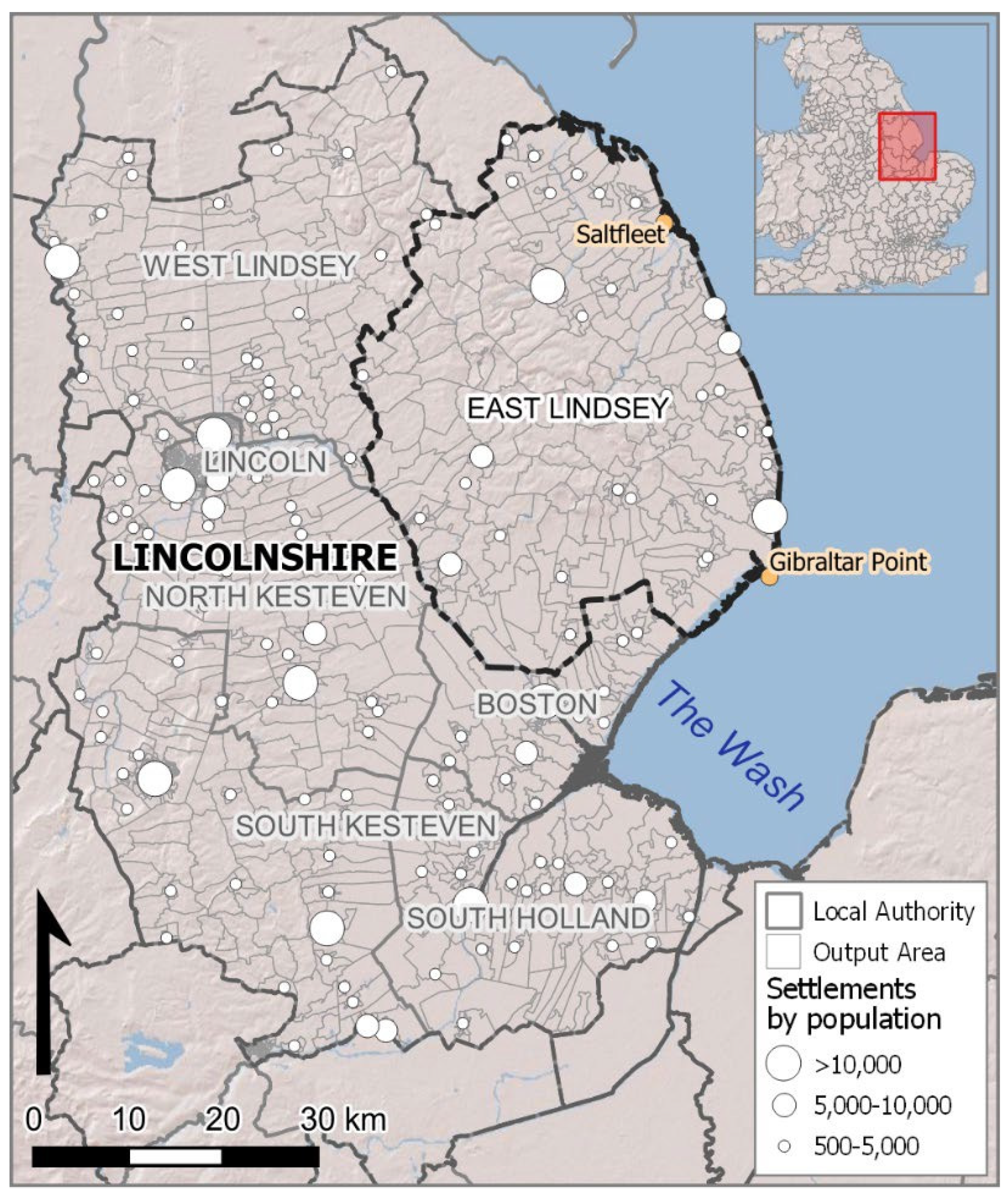
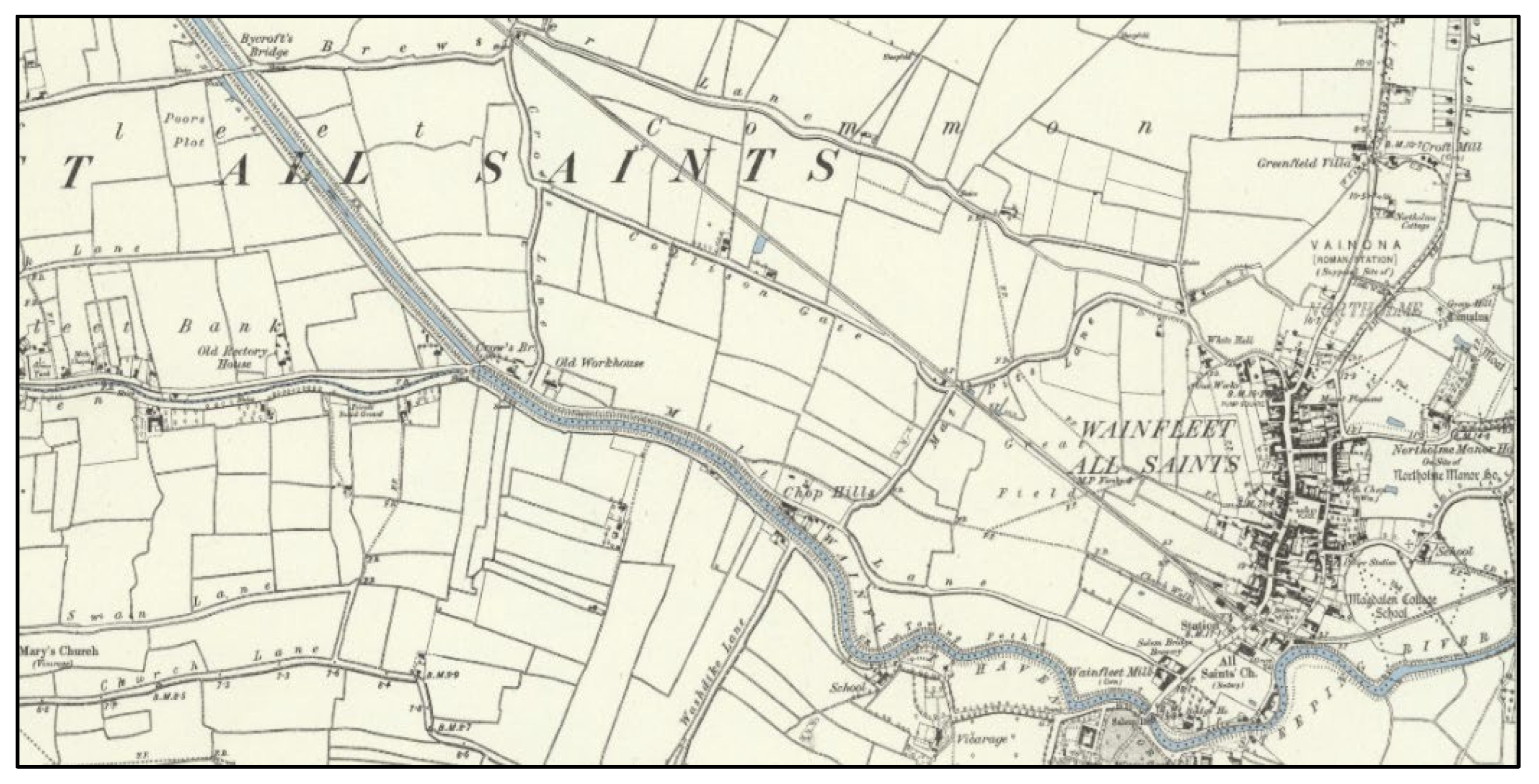
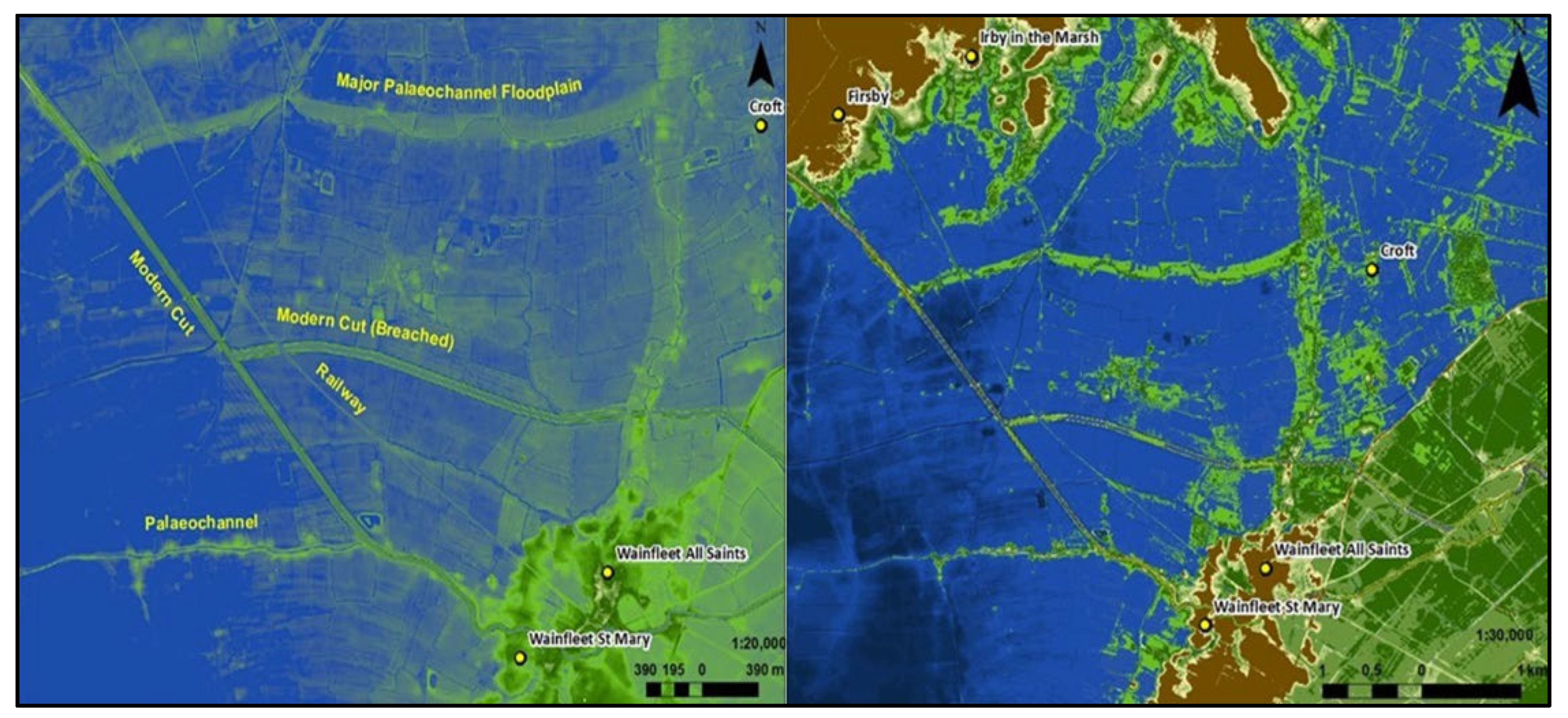

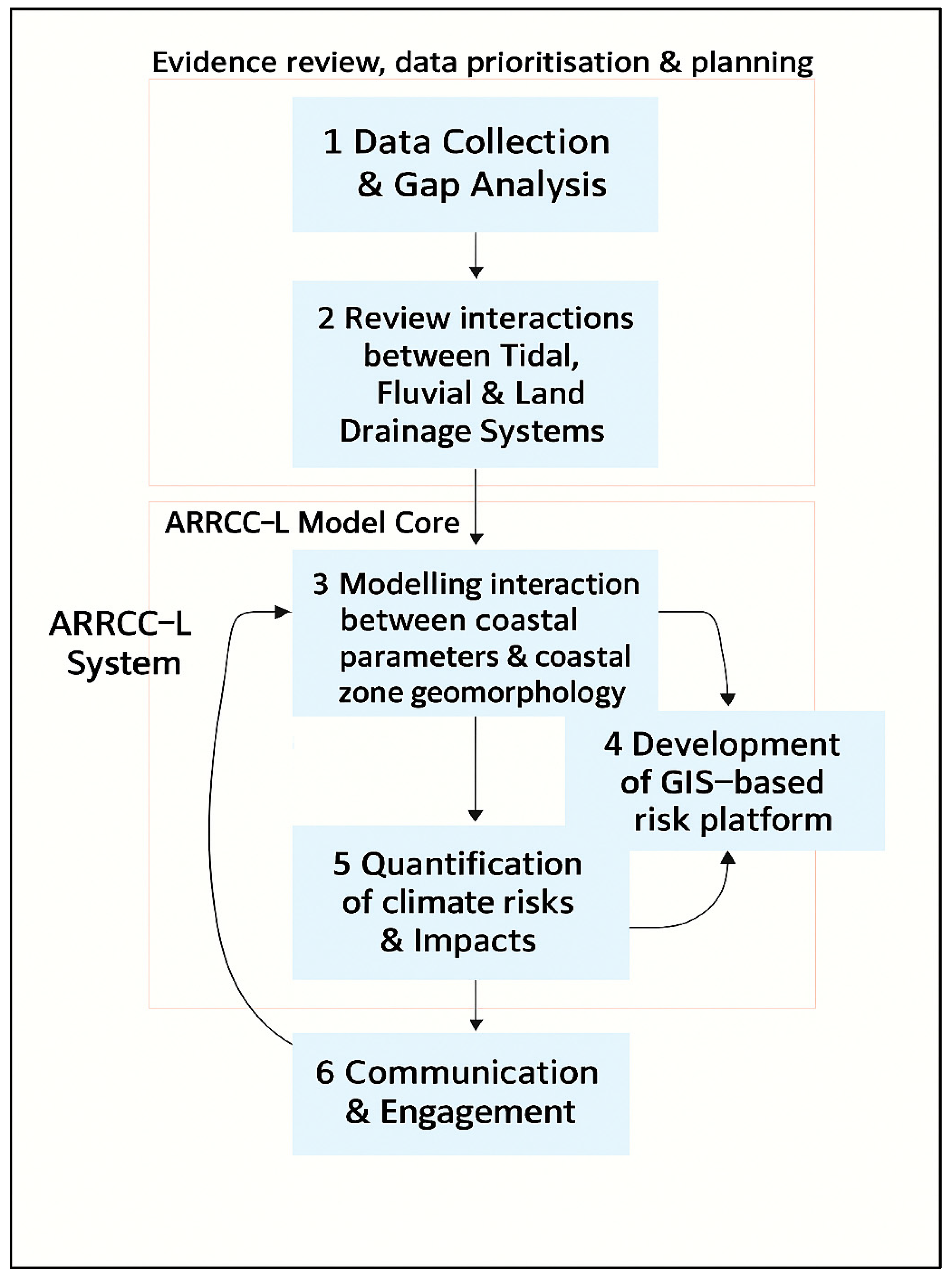

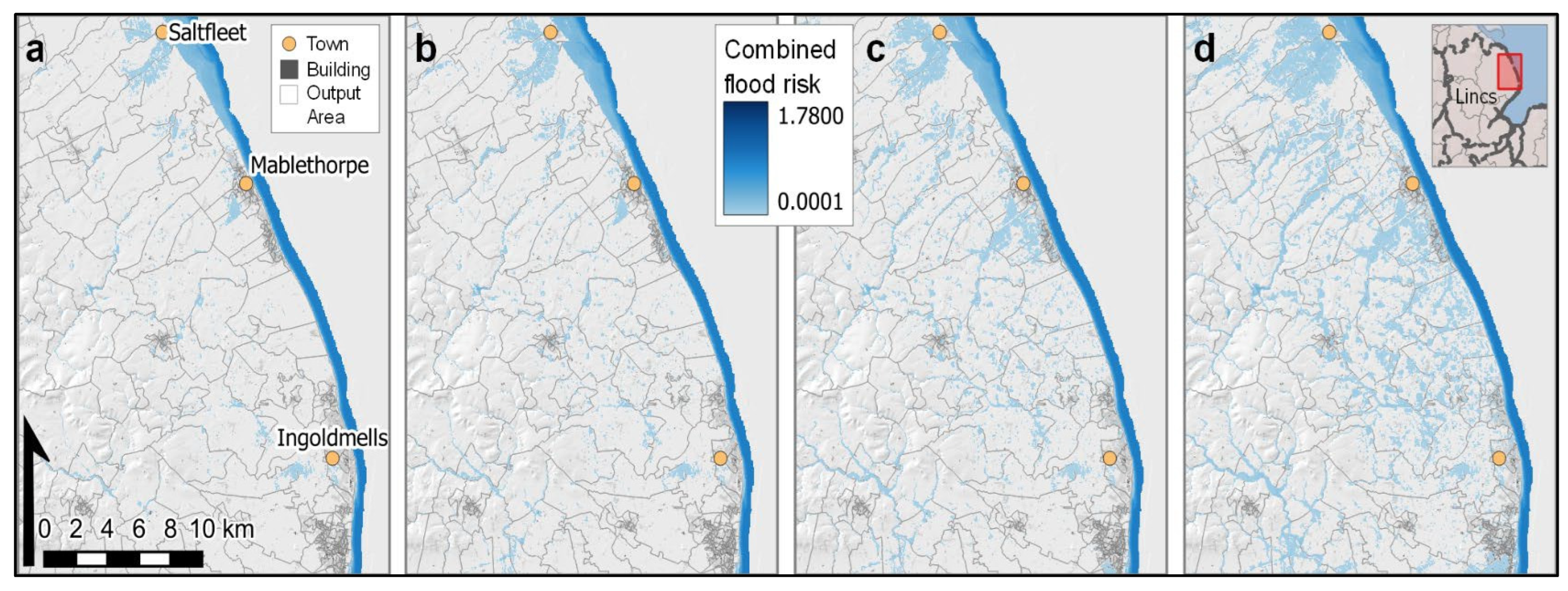
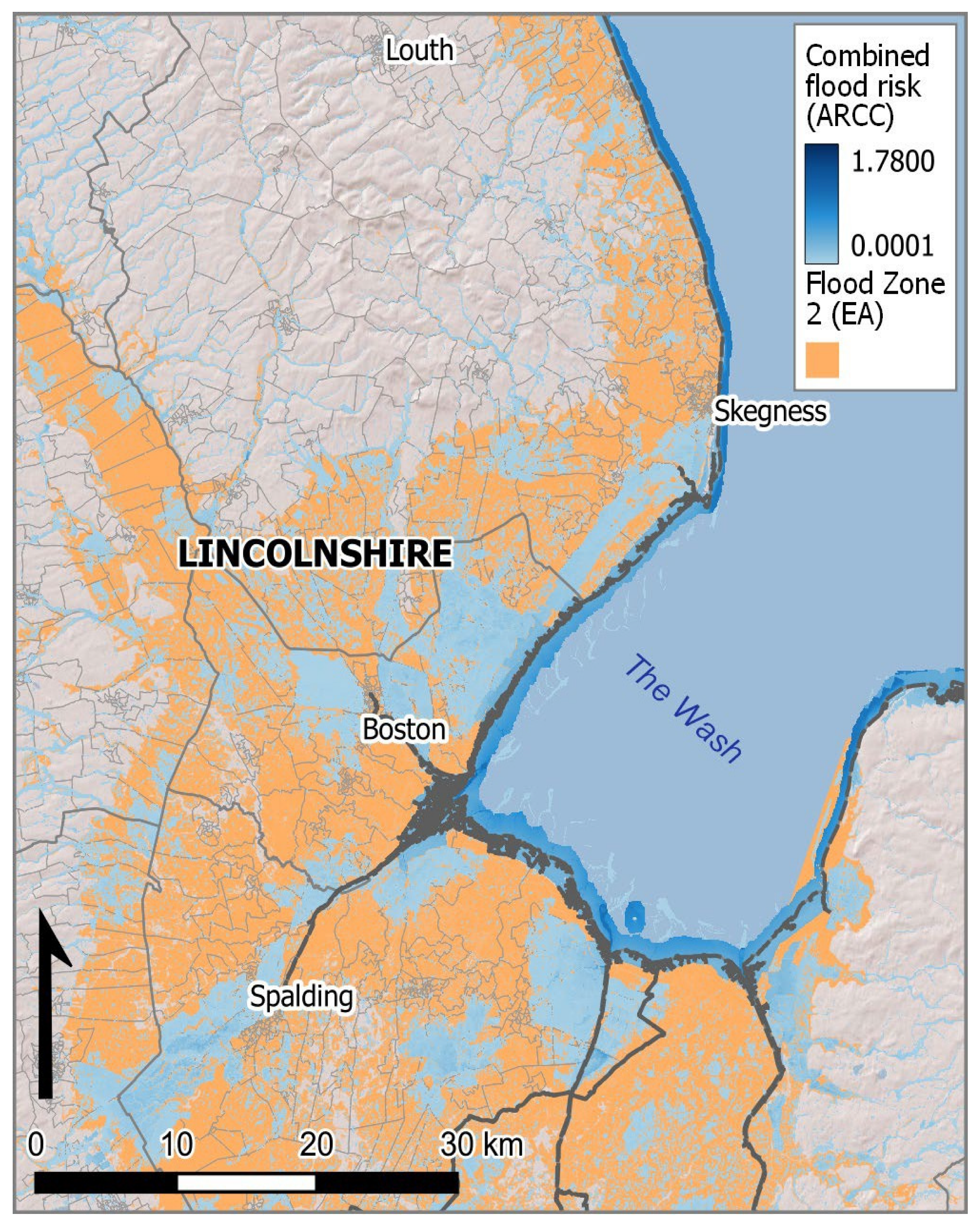
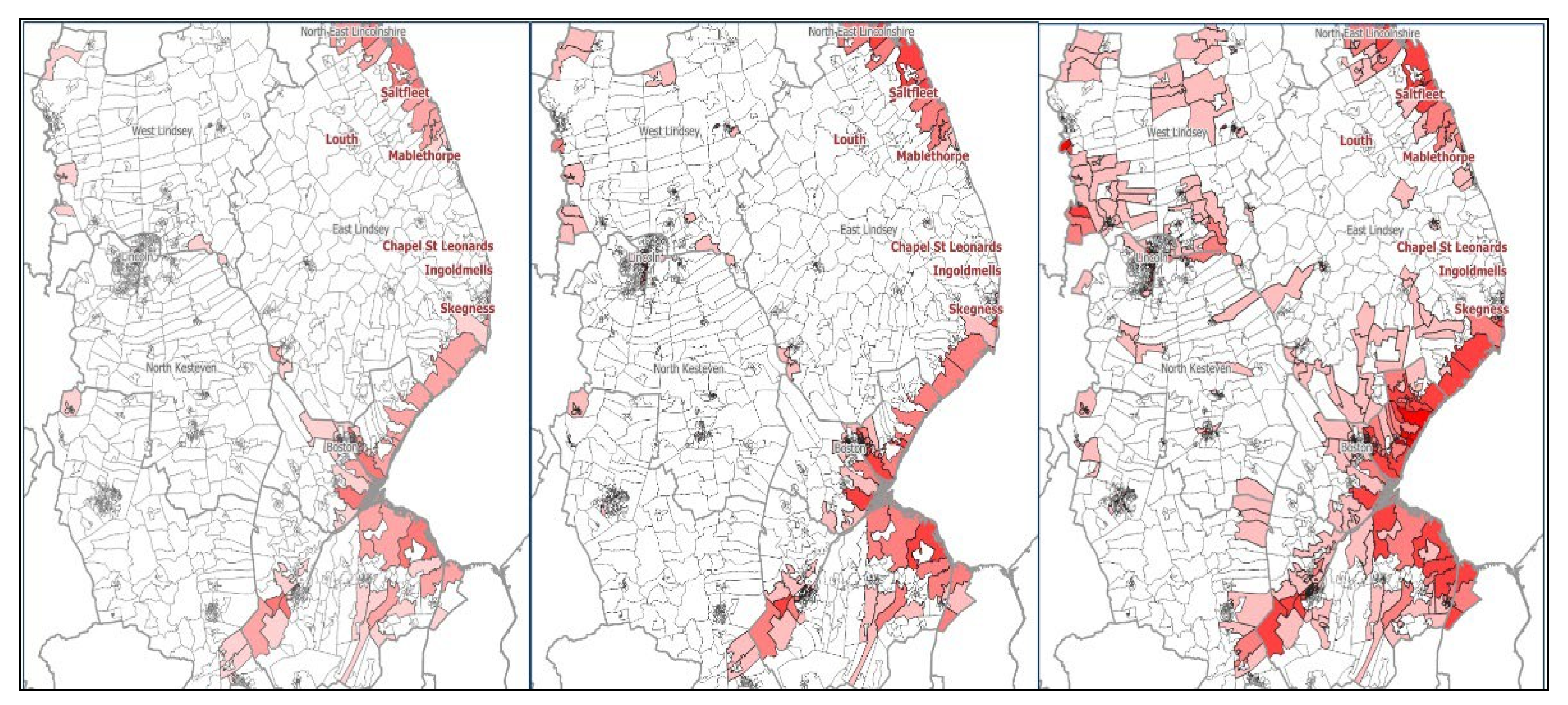
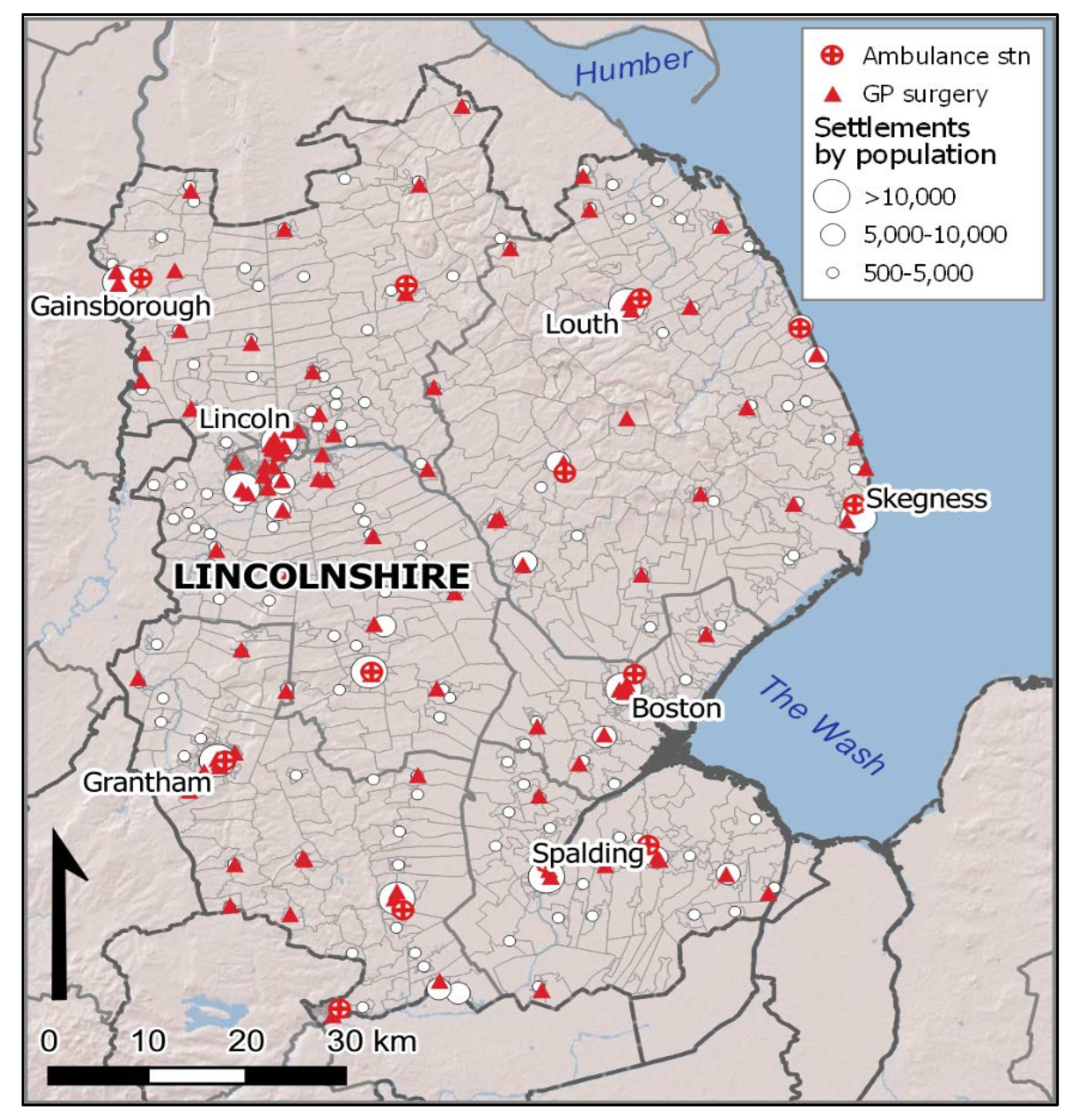
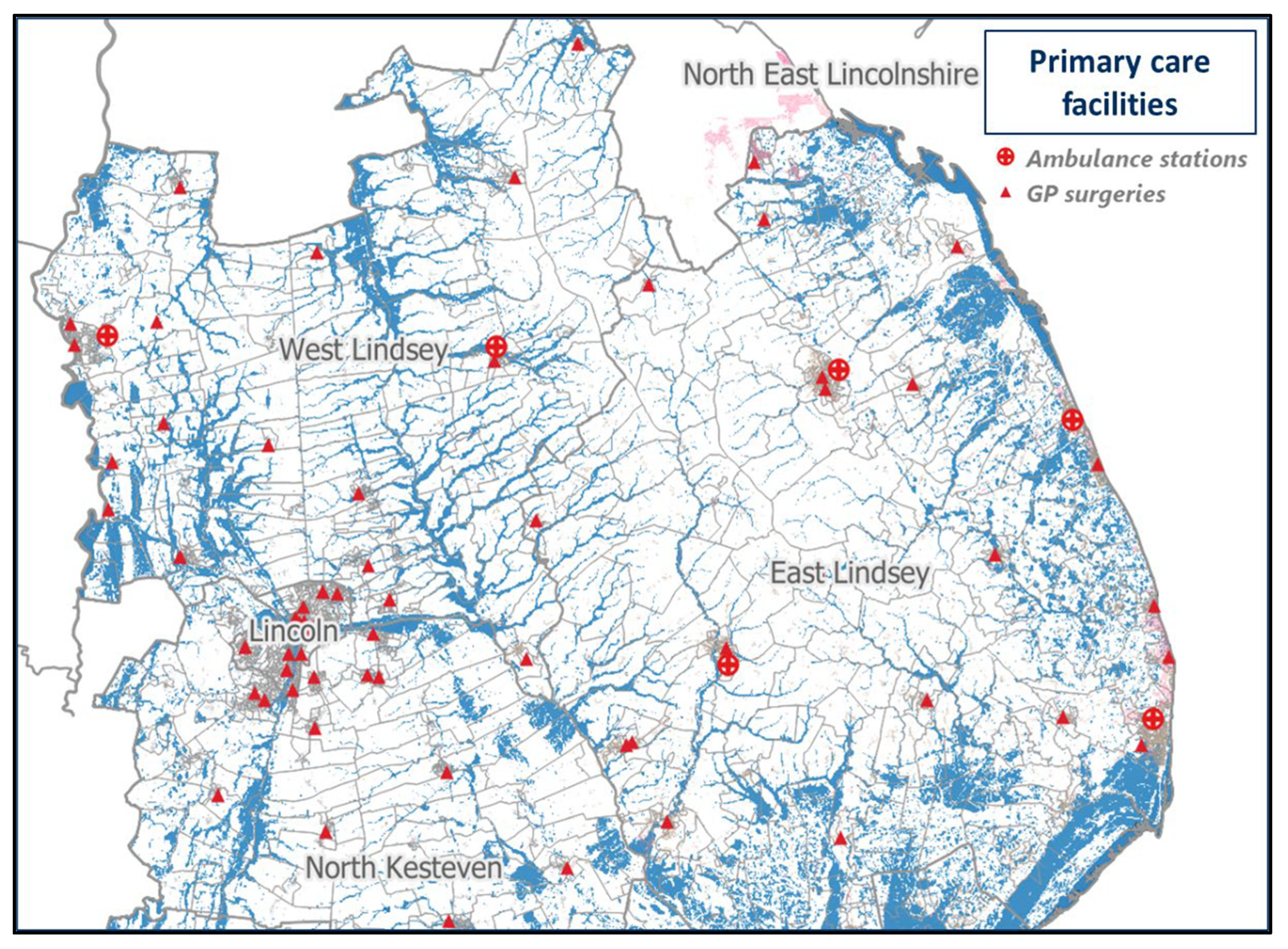

| Region | Representative Concentration Pathway (RCP) | ||||
|---|---|---|---|---|---|
| Year/Horizon | Lincolnshire | 1.5 | 2.6 | 4.5 | 8.5 |
| 2020 (abs) | 8716 | 9038 | 12,344 | 19,028 | |
| 2020 (%) | 1.8 | 1.87 | 2.55 | 3.94 | |
| 2030 (abs) | 8943 | 9656 | 12,712 | 19,456 | |
| 2030 (%) | 1.85 | 1.99 | 2.63 | 4.02 | |
| 2050 (abs) | 9012 | 10,112 | 13,154 | 19,935 | |
| 2050 (%) | 1.86 | 2.09 | 2.72 | 4.12 | |
| 2070 (abs) | 9145 | 10,342 | 13,386 | 20,038 | |
| 2070 (%) | 1.89 | 2.14 | 2.77 | 4.14 | |
| 2100 (abs) | 9578 | 10,551 | 13,993 | 22,115 | |
| 2100 (%) | 1.98 | 2.18 | 2.89 | 4.57 | |
Disclaimer/Publisher’s Note: The statements, opinions and data contained in all publications are solely those of the individual author(s) and contributor(s) and not of MDPI and/or the editor(s). MDPI and/or the editor(s) disclaim responsibility for any injury to people or property resulting from any ideas, methods, instructions or products referred to in the content. |
© 2025 by the authors. Licensee MDPI, Basel, Switzerland. This article is an open access article distributed under the terms and conditions of the Creative Commons Attribution (CC BY) license (https://creativecommons.org/licenses/by/4.0/).
Share and Cite
O’Shea, T.; Cross, D.; Macklin, M.G.; Thomas, C. Advancing Sustainability and Resilience in Vulnerable Rural and Coastal Communities Facing Environmental Change with a Regionally Focused Composite Mapping Framework. Sustainability 2025, 17, 8065. https://doi.org/10.3390/su17178065
O’Shea T, Cross D, Macklin MG, Thomas C. Advancing Sustainability and Resilience in Vulnerable Rural and Coastal Communities Facing Environmental Change with a Regionally Focused Composite Mapping Framework. Sustainability. 2025; 17(17):8065. https://doi.org/10.3390/su17178065
Chicago/Turabian StyleO’Shea, Thomas, Dónall Cross, Mark G. Macklin, and Chris Thomas. 2025. "Advancing Sustainability and Resilience in Vulnerable Rural and Coastal Communities Facing Environmental Change with a Regionally Focused Composite Mapping Framework" Sustainability 17, no. 17: 8065. https://doi.org/10.3390/su17178065
APA StyleO’Shea, T., Cross, D., Macklin, M. G., & Thomas, C. (2025). Advancing Sustainability and Resilience in Vulnerable Rural and Coastal Communities Facing Environmental Change with a Regionally Focused Composite Mapping Framework. Sustainability, 17(17), 8065. https://doi.org/10.3390/su17178065






